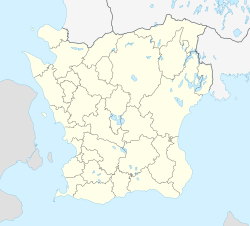Lund | |
|---|---|
Clockwise from top: Lund Cathedral and Lundagård; Lund University Main Building; Lund University library. | |
| Motto: Idéernas stad (Eng: The city of ideas) | |
| Coordinates: 55°42′14″N 13°11′42″E / 55.70389°N 13.19500°E | |
| Country | |
| Province | Scania |
| County | Scania County |
| Municipality | Lund Municipality |
| Area | |
| • Total | 26.37 km2 (10.18 sq mi) |
| Population (2020)[1] | |
| • Total | 94,393 |
| • Density | 3,580/km2 (9,300/sq mi) |
| Demonym(s) | Lundensare, Lundabo |
| Time zone | UTC+1 (CET) |
| • Summer (DST) | UTC+2 (CEST) |
| Website | lund |
Lund (/lʊnd/, US also /lʌnd/ LU(U)ND,[2][3][4][5] Swedish: [ˈlɵnːd] ) is a city in the southern Swedish province of Scania, across the Öresund strait from Copenhagen, Denmark. The town had 91,940 inhabitants[6] out of a municipal total of 121,510 as of 2018[update].[7] It is the seat of Lund Municipality, Scania County. The Öresund Region, which includes Lund, is home to more than 4.1 million people.[8][9]
Archeologists date the foundation of Lund to around 990, when Scania was part of Denmark. From 1103 it was the seat of the Catholic Metropolitan Archdiocese of Lund, and the towering Lund Cathedral, built c. 1090–1145, still stands at the centre of the town. Denmark ceded the city to Sweden in the Treaty of Roskilde in 1658, and its status as part of Sweden was again confirmed in following peace treaties.
Lund University, established in 1666, is one of Scandinavia's oldest and largest institutions for education and research.[10][11][12] The university and its buildings dominate much of the centre of the city, and have led to Lund becoming a regional centre for high tech industry.
- ^ a b "Localities 2020; population and land area by locality and municipality". scb.se. Statistics Sweden. 24 November 2021. Archived from the original on 19 December 2021. Retrieved 19 December 2021.
- ^ "Lund". The American Heritage Dictionary of the English Language (5th ed.). HarperCollins. Retrieved April 13, 2019.
- ^ "Lund". Collins English Dictionary. HarperCollins. Archived from the original on April 13, 2019. Retrieved April 13, 2019.
- ^ "Lund" Archived 2019-04-13 at the Wayback Machine (US) and "Lund". Lexico UK English Dictionary. Oxford University Press. Archived from the original on 2020-08-03.
- ^ "Lund". Merriam-Webster.com Dictionary. Merriam-Webster. Retrieved April 13, 2019.
- ^ "Folkmängd per tätort efter region och vart 5:e år" (in Swedish). Statistics Sweden. Retrieved 2019-07-22.
- ^ "Folkmängd i riket, län och kommuner 30 juni 2018 och befolkningsförändringar 1 april–30 juni 2018. Totalt". Statistiska Centralbyrån. Archived from the original on 2019-03-14. Retrieved 2019-01-18.
- ^ "Öresundsregionen har passerat 4 miljoner invånare". Archived from the original on 2021-04-03.
- ^ "FAKTA: Öresundsregionen har 4,1 miljoner invånare". 22 February 2021. Archived from the original on 2021-04-03.
- ^ Lund University Archived 2016-11-14 at the Wayback Machine, The Solander Program Website
- ^ Universities in the Øresund Region Archived 2008-04-21 at the Wayback Machine, Øresund Entrepreneurship Academy Website
- ^ "Start - Lunds universitet". Archived from the original on 2006-12-07.






